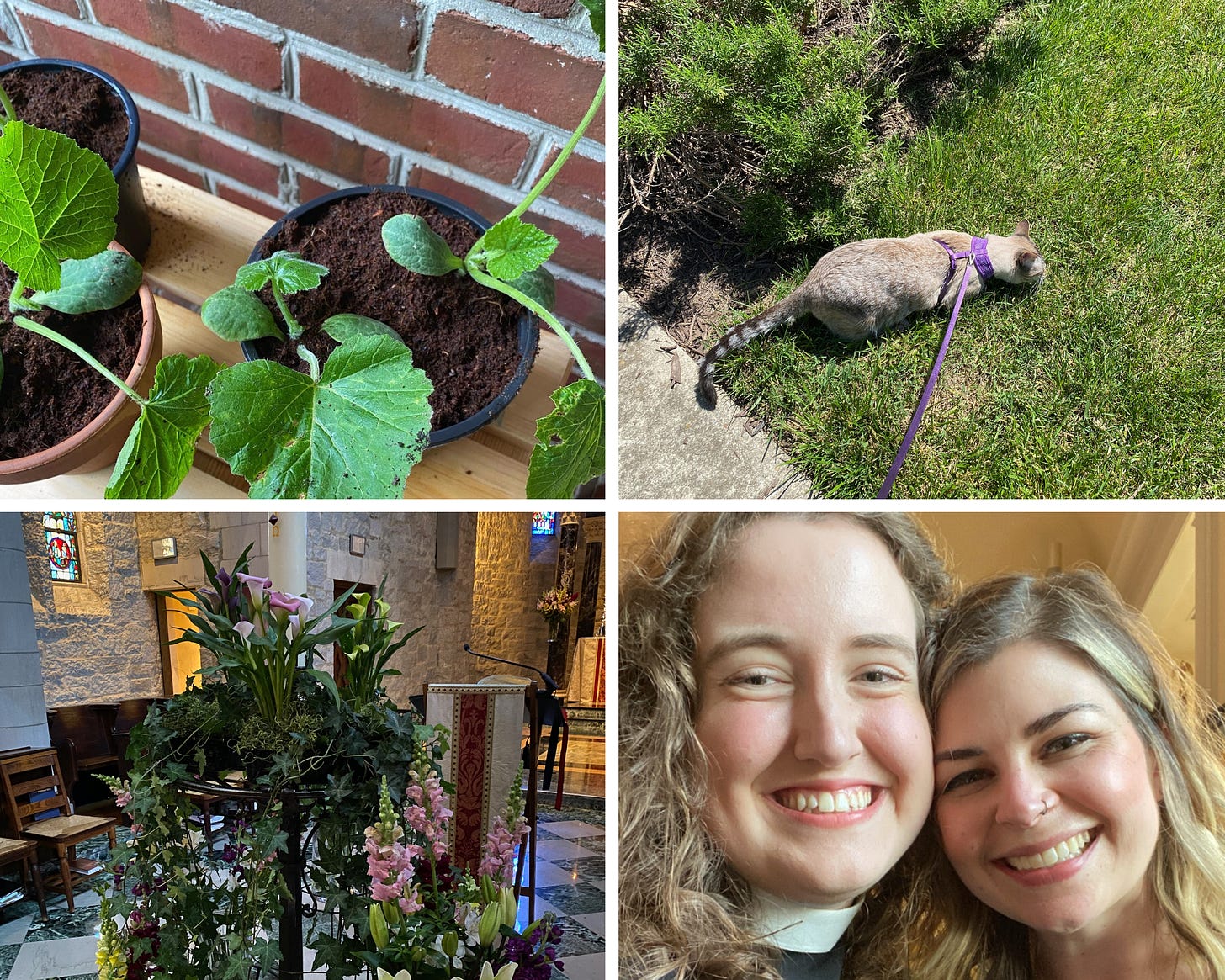I am back to writing these newsletters! It’s been a bit of a chaotic Easter season thus far, and on top of that, I’ve been thinking about what I want this email to be, and brainstorming essay ideas. Needless to say, this will continue, and I’m excited to use this platform to write about things like sustainability, hobbies, ethics, and other smatterings that don’t make it into writing elsewhere. Thanks for coming along on the journey.
It is now fully gardening season in the MidAtlantic, and I find myself gardening everywhere. I mean this literally—at home, the porch container garden and indoor seed-starting; at friends’ raised bed that I’ve agreed to help cultivate this year; at work, where my boss’s office windows are now lined with containers (revitalized from previous garden attempts before my time) filled with kale and chard.
This year, my garden work feels like a particular effort in working towards climate justice. There is, both, the practical fact that homegrown food has fewer miles, and if grown from seed, can be fairly cost-effective (particularly greens and other veg that are easy and inexpensive to reseed). But I’ve also become convinced over the last few years of the importance of sourcing sustainable gardening products as well—particularly because my container garden and seed-starting relies heavily on potting soil, a product that is largely unsustainable.
In order for potting soil to exist as a lightweight medium that provides perfect growing conditions for a variety of plants, soil must be amended with nutrients and other materials. Most potting soils on the market rely on peat products to provide the appropriate aeration—peat which is harvested from peatlands across the world. Peatlands include environments like bogs and swamps that have wet, marshy conditions which are enriched by millions of years of decomposed biomaterials. Not only do these environments promote biodiversity, but they also lock huge amounts of greenhouse gasses like carbon deep into the soil. Logically, of course, extracting peat products results in the release of these carbon stores into the atmosphere, further perpetuating our climate crisis.
In recent years, activists and sustainability leaders have become increasingly vocal about the need to step away from our dependence on peat. I first learned about this as an issue while watching the UK program Gardeners’ World, and in general, it seems that industry leaders in the UK are much further ahead on this than in the US. This is not terribly surprising to me, as my own anecdotal evidence is that gardening is far more of a cultural norm in the Atlantic Isles (as Diarmaid MacCulloch refers to them in The Reformation: A History) than it is for those of us in the US (who are often content to pay a lawn service and be done with it).
Fortunately, there are other options, which I’ve tried to adopt this year. The most-widely available is coconut coir, which is the ground up shell of the coconut. Although less nutrient-rich than peat, it is a lightweight medium that can easily be amended or fertilized, and can substitute for potting soil. My favorite thing about it is that it comes in bricks or cubes which you put in water to decompress. (It brings back childhood memories of those washcloths you put in water and watch unfurl!) For seed-starting, I’ve used small discs of coir that come encased in a biodegradable mesh, and expand into 2-3 inch tall plugs.
Although peat industry folks are quick to point out that only a small percentage of overall peatlands are being used for horticulture products, for me, this is a pretty easy choice to make that makes relatively little financial difference to my hobby budget. It is the kind of individual choice that seems small in the grand scheme of climate-related tasks we must do, but it is still something. And in the face of the paralyzing consequences of climate inaction, doing something still matters, no matter how small. That’s what I tell myself at any rate, since, what else, really, can we do other than our small somethings? And every time I step outside (away from my computer and the never ending news stories that posture themselves as the only reality), I am reminded that the small kale leaves and dahlia shoots waving in the breeze are also a reality—one that I would rather spend my time in.
Happening this Week
It feels like summer! Not just because of the weather, which has been brutal (if you love the cold as much as I do, but also because both higher education institutions I’m affiliated with are done with graduation and academic year classes. The veg are loving it, and I’m excited to continue partaking in the bounty of a flourishing garden.
Since we last spoke, I’ve traveled to Boston for a week, to spend Holy Week and Easter with one of the communities I’m grateful to call home. I’ve done a few weeks of supply at parishes, and attended several diocesan functions. Last night was a celebration of new ministry for a seminary friend, which (as these things do), turned into a mini-VTS reunion.
There’s a couple of research projects lurking on the horizon that I’m very excited about, and honestly, I think I’m just going to adopt the title Research Assistant For Hire. At least one of them will involve some serious archives work, which as a historian, I love. As always, I will tell you about the ones that I can when they’re published, and talk mysteriously and vaguely about the ones that I can’t.
Wishing you a lovely week, friends!


